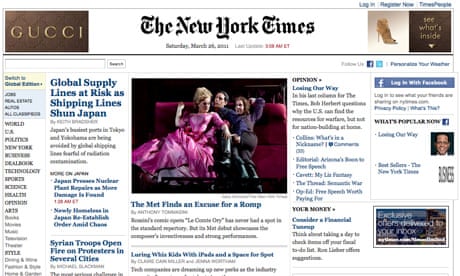It is a week since the New York Times finally set a date and a plan for rolling out its notorious "pay sponge"; the barrier previously known as a paywall is both absorbent and strong, so maybe it can get sponsorship from Andrex. Indeed the technology press gleefully reported that the barrier could be hacked with "four lines of code", although in fairness the core Times audience could no more install, write or apply four lines of code than fly. The "pay sponge" announcement triggered a rush to the recycling plant for old arguments; the 'pro' and 'con' skips are now brimming with regurgitated views of all kinds.
The focus on the erection of this semi-secure barrier has generated far more interest than the economics of its merit, largely because it represents an iconic moment, particularly in the US; a totem for the rest of the industry, and a retrenchment of the way that digital and non-digital companies do business. In many ways the hole-in-the-wall uncertainty about how secure or porous the pay barrier is, represents the internal dilemma of the NYT and many others. How much of the digital world is it? In seeking to preserve the payment structures of old while enjoying the benefits of the new world, the inevitable question is whether it will end up compromising its future in both.
The New York Times announcement even produced a potential "Gerald Ratner" moment when, during an interview at the Paley Center, NYT publisher Arthur Sulzberger said he thought the kind of people who would be paywall dodgers would be "high school kids and people out of work". It is worth watching the video of the event to capture this moment at about 20 minutes in; Sulzberger's observation that "I can hardly believe I said that" is the most resonant part of the interview.
In the welter of opinion which followed the announcement, some voices stood out. Former New York Times designer Khoi Vinh wrote a very trenchant analysis on his blog.
Vinh is worth reading, as he is one of the member's of staff who left in 2010 partly because of the dominance of the paywall project within the company. His argument is one centered on what the Times might have given up in focusing so much time and resource – two years and $40m – on the project. Contrast it with the views of media commentator David Carr, still a New York Times staffer, who wrote a contrasting piece at the weekend, stating the oft-repeated case that good journalism costs money and someone has to pay.
The "opportunity cost", as Vinh points out, of spending potentially $40m on erecting a payment system is unknown and unmeasurable. There are plenty of hot startups which cost less to get off the ground and which are potentially going to be worth more. The virtual coupon business Groupon is one; Foursquare, which launched in March 2009, and in two rounds of funding took only half the cost of a paywall, is another. Even the mighty Twitter is only five years old and initially cost far less. At the technology music and film festival South by Southwest last week there were any number of interesting new applications and startups all gathering on the turf of linking information with social activity, which is actually the very definition of what the press has been, but as an industry news has entirely failed to capitalise on this shift.
Sitting in a room of Silicon Valley entrepreneurs about six years ago with other newspaper executives, there was a very uncomfortable line of conversation which made us all shift defensively in our seats. They pointed out, very politely, that we were "having our lunch handed to us" because, as an industry we had not for instance thought hard enough about how to connect our readers with advertising of value to them in a way which would benefit both sides of the equation. Google had done this, and that's why it were successful and newspapers were not, ran the irritatingly faultless argument. Afterwards one newspaper executive commented that this was all very well, but "they are not in our business". Except of course they were and still are.
It has been a familiar and recurring theme that while we see almost daily innovations spilling out of news organisations in terms of presentation of news, and the process of journalism, we still see very few commercial directors who are not trying to rework advertising sales or circulation revenues. And while there is an increasing recognition that advertising is decoupled from content in a way that argues for a far more radical reinvention of commercial models within news organisations, the evidence of this actually happening is very sparse.
Most legacy news organisations are challenged by three potential areas of failure. One is a lack of understanding at the highest level what the progression of technology means. The second is the speed with which rigid editorial structures nailed down for fixed products can adapt to changing editorial models, and the third is high-level experience of making money in a digital world outside sales and distribution. In the US this is likely to become the most pressing issue as newspaper companies end what by many accounts has been a very tough quarter for print revenues.
One other troubling thought about the Times's expenditure of $40m: if the creation and implementation of these structures really is the future of revenue for content, then why isn't the world of startups and VCs abuzz with it in the same way as legacy news organisations? It would be interesting to see where $40m invested by this world now will have led in five years' time, and how the Times is faring then.

